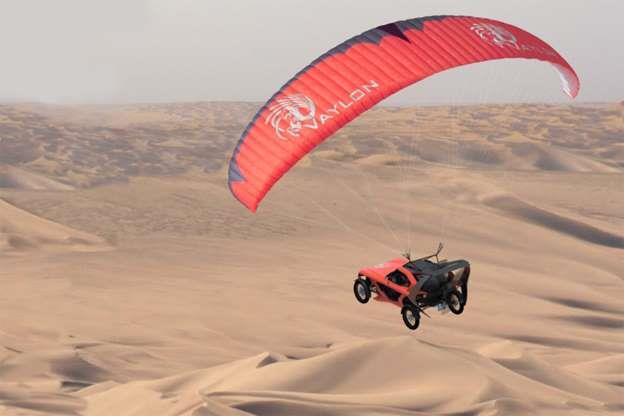The Pégase is a buggy and paraglider in one built by French company Vaylon. At one moment you can be tearing it along a beaches of Dover and the next you can take to the skies to fly across the Channel. Pilot Bruno Vezzolli has proven it can be done in 50 minutes.
The Pegase project has for objective to design, manufacture and commercialize a new way of mobility that allows going beyond the road and airport constraints.
The vehicle was been developed in the objective to be very easy to handle, as the user could be as free as possible. The vehicle targets double air/road certifications. It is a buggy on the ground and an ULM in the air (European Ultra-light Aircraft) certification or LSA (Light Sport Aircraft), particularly as Powered Paraglider (PPG).
As an ULM, Pegase does not need runways or airfield facilities. Thus, it can take off and land on everywhere with the authorization of the owner.
This vehicle is really innovative in term of usage.
As this new vehicle can easily change of environment (air or ground), it offers to its users new solutions of abilities and a more efficient way to succeed in missions.
Its performances, double ability (air/ground), low operating cost and its easy training aspect are the main assets of the Pegase which will satisfies private, professional and military users.
A free template by Lucknowwebs.com for WYSIWYG WebBuilder 8
Nigel G Wilcox
Paragon Of Space Publication
© Copyright Reserved - United Kingdom
Ideal Screen Composition 1024 x 768
Best Flying Cars Around the World
F-35 Lightning II
© 2019 Vaylon
Vaylon Pegase
Max Speed: 50mph
Max Altitude: 3000 metres
Engine: Rotax 912 Boxer
Range: 620 miles
Vaylon Pegase
Courtesy: pocket-lint.com/Vaylon
Approval referred: European Heavy Quadricycles (L7 category)
EU 4 emissions standard (EU 5 in 2020)
Specifications
Speed: 60 mph (100km/h)
Off-road abilities
Urban mobility
Autonomy
Range > 300mi (500km)
Fuel consumption 5l/h
Refueling at Gas station
Advantages
Robustness, high resistance of the cell
Air Mode
Approval referred: France: DGAC ULM Powered paraglider (PPG)
US: LSA (Light Sport Aircraft)
Specifications
Air speed = 50mph (80km/h)
Altitude: up to 10 000 ft (3000 m)
Take off distance: 160/330ft (50-100m)
Landing distance: 30/100ft (10-30m)
Autonomy
2.30 / 3 hours flight
Payload
US standard: until 550lbs (250kg)
Advantages
Crossing dry or wet obstacles
Freedom of flight, STOL aircraft (Short Take Off and Landing), this vehicle can take off and land on poorly prepared fields.
The vehicle can approach sensitive or difficult-to-access areas by air. It can keep at the same time a high road autonomy and a rapid intervention capacity on the ground.
Multifunction vehicle
Pegase can be used in various environments and is has fast intervention capabilities. The double capacity (ground/air) allows a lot of field mission executions depending on the selected transport mode.
This vehicle can take off and land on poorly prepared fields. The vehicle can approach sensitive or difficult-to-access areas by air. It can keep at the same time a high road autonomy and a rapid intervention capacity on the ground.
Moreover, the three main functions - flight, urban mobility and off-road - answer to European standards.
Its top speed on ground is 60 mph (100km/h) and 50mph (80km/h) in the air.
Its lightness, good ground clearance, performing suspension system and limited-slip rear differential make it easier to drive on rough fields with good crossing capacity.
In flight mode, Pegase as a short take-off and landing (STOL) aircraft which gets over runways or airfield facilities and so take-off and landing on all terrain in accordance with EU aviation standard (ULM).
SITEMAP
SCIENCE RESEARCH
ABOUT
Desk
MAIN INDEX
Flying Cars
S'sonic
Stealth
Menu
Space
Transport
Menu
Topic
Menu
Study
Menu



